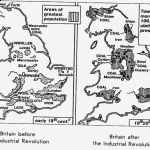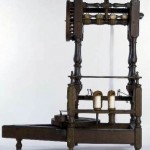Industrial Revolution
Category: 18th century In 1700 there was only a scatter of industries. Woolen manufacture, the most important, was dependent on the rural population spinning and weaving in their own homes. The word spinster is still used for an unmarried woman. Cloth was greatly valued.
In 1700 there was only a scatter of industries. Woolen manufacture, the most important, was dependent on the rural population spinning and weaving in their own homes. The word spinster is still used for an unmarried woman. Cloth was greatly valued.
Wool was greatly valued too, because the rise and fall of rents was held to depend upon its price. There were three great areas of cloth production: East An-glia, the South West, and the West Riding of Yorkshire. There was also a nascent cotton industry. Cotton, originally called “Cyprus wool”, was imported from the Levant and the West Indies, and although legislation intended to protect the woolen industry checked the manufacture of cotton goods, cloth was woven of cotton and wool and in Lancashire there were foundations of a cotton industry.
 Cotton goods were a promise of wholesome exchange; they could be washed more easily than wool, and a clean shirt came to be the characteristic of an eighteenth-century gentleman. The demands of the town and of the tropics encouraged the making of lighter fabrics. Oriental influence was strong throughout Europe’s textile industry, and in England, Indian chintz was imitated by printing on white calico or linen.
Cotton goods were a promise of wholesome exchange; they could be washed more easily than wool, and a clean shirt came to be the characteristic of an eighteenth-century gentleman. The demands of the town and of the tropics encouraged the making of lighter fabrics. Oriental influence was strong throughout Europe’s textile industry, and in England, Indian chintz was imitated by printing on white calico or linen.
Between 1700 and 1750 the English came to equal the Dutch in the arts of dyeing and finishing cloth. The white cloth was still exported to Holland, but the final processes which were the key to the market passed into English hands.
The prosperous woolen industry and the nascent cotton industry were incentives to the improvement of the process of spinning and weaving — which are near the heart of the Industrial Revolution. In 1733 John Kay’s weaving machine known as the flying shuttle made it possible for a weaver to operate wider loom and doubled the pace of working.
The spinning jenny of James Hargreaves in 1765 enabled a number of spindles to be worked simultaneously. Hargreaves was an uneducated weaver from Lancashire, and he called his machine a “jenny” after his younger daughter. He received a patent for his invention in 1770, and soon thousands of jennies were working at the mills.
The spinning frame invented in 1768 used rollers revolving at different speeds to draw out the twisted yarn and produced a stronger thread than the spinning jenny. Richard Arkwright, its inventor, had no schooling and did not learn to read and write until he was middle-aged. However, he invented several textile manufacturing machines besides the spinning frame. In 1779 Samuel Crompton’s mule combined the spinning jenny and the water frame, and made it possible to spin a finer yarn than any before produced in England. Ark-wright’s machine was driven by waterpower; Crompton’s mule was at first worked by hand, but was later adapted to waterpower, and the first loom made by Edmund Cartwright was driven by a bull.
The invention of the cotton gin in 1793 led to even more growth in the textile industry. Removing the sticky seeds from cotton by hands was a slow process until an American, Eli Whitney, devised a machine that could do the work of fifty people.
New weaving and spinning machinery soon revolutionized the way cloth was made. Textile makers built large factories to house the new machines. Many workers now went to the new factories to do jobs for wages instead of making goods at home. Those who lived too far away for daily travel moved to the new towns that sprang up near the factories. A sizable component of the work force was formed by women and children. This was the first time large numbers of women had gone to work for wages on other than domestic service. Most of the factory workers were people from rural areas who were displaced by the enclosure movement.
Machinery, however subtle, would not have transformed the world without a new source of power. Wind and water remained the principal power sources in the early eighteenth century. A prime mover more powerful, more efficient, and less restricted in application than wind and water was needed.
Since the beginning of the 17th century inventors had been working to create an efficient steam engine. The first steam engine was built in 1691 by Thomas Savery, a military engineer. It could be used to pump water out of a mine or well, but it was dangerous to use because it required enormous steam pressure which could easily burst the pipes.
Thomas Newcomen, a blacksmith, a native of Derbyshire, invented in 1708 a steam engine which was operated by atmospheric pressure acting on a piston in a vertical cylinder open at the top and closed at the bottom. Newcomen engines were to be installed in many parts of England, also in Russia, Sweden, France, and Hungary.
About 1760 a Newcomen engine was erected at mine in New Jersey. But the vital advance in the provision of a new source of power came when James Watt learned from Joseph Black the theory of latent heat. In the Newcomen engine a considerable amount of latent heat was lost without doing useful work. The solution of the problem was to add a separate condenser to the cylinder and piston of the Newcomen engines. It would not have been a practical success had it not been for a cannonmaking machine which could bore a truly cylindrical hole in iron. Cylinders made by John Wilkinson of Bersham were vital to the early steam engines. In 1776 the first steam engine was ready for the market in the English blast furnaces.
Watt’s steam engines began to transform British industry. Iron manufacturers used them to drive the great hammers that crushed the iron. In coal-mining, men and women no longer had to carry the coal to the surface in sacks as it could be lifted up by winding-gear powered by the Watt engine. The textile industry used the engine to power the new machinery invented by Richard Arkwright.
The eighteenth-century England was divided into industrial provinces. There were textiles in Lancashire and Yorkshire, metal in the west Midlands. The coal and iron districts of the Midlands and Gloucestershire were near the Severn River, which was a useful transport system. Each industrial region had at least one large town, which acted as a local capital. The more skilled workers would be there, and reputations in Particular crafts could be made. At Sheffield there were the razors and knives, and the skilled artisans who worked at home or in a nearby shop were still common. He might have one or two assistants. Even shipbuilding, except the ships built for the Royal Navy or he East India Company, was carried on in small yards. The houses of all but the rich were built by bricklayers and carpenters.
Industrial production was often for local markets. But light and portable goods could be carried over bad roads and still pay their way, as gold and precious stones were worth their months of travel from ancient East. Stockings came from Nottingham and Leicester, toys and nails from Birmingham, cutlery from Sheffield, and hats from many districts.
The nation’s changing population provided a ready source of labour and a growing market for goods. Colonies also provided Britain with both markets for manufactured goods and raw materials. Many British merchants profited from this trade.
